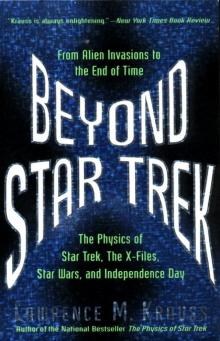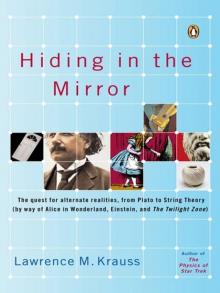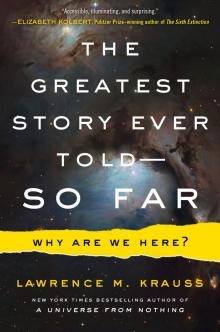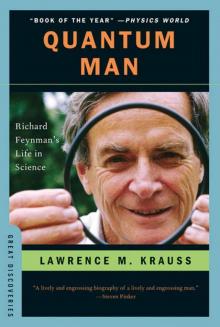- Home
- Lawrence M. Krauss
Quantum Man: Richard Feynman's Life in Science Page 9
Quantum Man: Richard Feynman's Life in Science Read online
Page 9
Meanwhile, during this impossible time, he and the other scientists at Los Alamos were proceeding at a frenzied pace toward the creation of a bomb that would change history forever. Emotions were high, and maybe that is what kept them going. When Germany was defeated, no one seemed to ask the question, Why are we building this bomb? Everyone wanted to see the fruit of their intense labors brought to light, to end the war in the Pacific.
To someone like me, who grew up in the era of big science and big bureaucracy, the remarkable intensity and speed with which the Manhattan Project was carried out are almost unfathomable. The time from when the bomb was mere theoretical speculation to the Trinity test was less than five years. The time from when Feynman and others were recruited was less than three years. The best physics minds, initially motivated by a belief that the enemy (Germany) was also developing a nuclear weapon, accomplished in three years what in the current world might take at least a decade or two. The mammoth isotope separation project at the Oak Ridge laboratory in Tennessee alone, which magnified by more than a millionfold the total amount of separated uranium 235 in the world during that three-year period—under very dangerous circumstances that Feynman was sent, in 1945, to try to correct—would probably take at least as long in the current world just to get environmental clearance before being allowed to begin.
Feynman had rushed to be by Arline’s side during her last hours on June 16, but after she died, he realized that the dead no longer need help, so he gathered her possessions, arranged for her immediate cremation, and amazingly returned to Los Alamos, shattered as he was, to report to work the next evening. Bethe would have none of this and ordered him to go home to Long Island for a rest. His family had no advanced warning that he was arriving, and he stayed until he received a coded telegram almost a month later summoning him back to New Mexico. He returned on July 15, was driven to Bethe’s house for sandwiches made by Bethe’s wife, Rose, and then caught a bus to a desolate desert location called Jornada del Muerto, where he would join his colleagues to watch the test of the device they had spent day and night for the last three years designing and building, the device that would change the world forever.
Everyone who saw the blast was awed, but differently. Some, like Oppenheimer, recalled poetry, in his case an obscure passage from the Bhagavad Gita: “Now I am become Death, the destroyer of worlds.” Feynman, who had managed to avoid superstition at the moment of his wife’s death, and sentimentality immediately afterward, held true to form. He thought about the processes that formed the clouds around the blast wave, and the processes that caused the air to glow as it became ionized in the heat of the explosion, and a hundred seconds later, by the time the sonic boom from the blast finally arrived at the observation deck, he was grinning. The calculations he had worked so hard on had been validated by nature.
CHAPTER 7
Paths to Greatness
There is pleasure in recognizing old things from a new viewpoint.
—RICHARD FEYNMAN
It was the best of times. It was the worst of times. Richard Feynman left Los Alamos in October of 1945 as a shining new star in the physics community. As early as 1943 Oppenheimer had tried to convince the chairman of the Physics Department at the University of California, Berkeley to offer him a position, saying, “He is by all odds the most brilliant young physicist here . . . his excellence is so well known, both at Princeton . . . and to a not inconsiderable number of ‘big shots’ on this project, that he has already been offered a position for the post war period, and will most certainly be offered others.” Oppenheimer was referring to an offer from the ever-astute Bethe, who by November of 1943 had arranged a faculty offer for Feynman at Cornell University such that Feynman was officially on leave from Cornell while at Los Alamos. The staid Berkeley chairman delayed making an offer until the summer of 1945, telling Feynman, “No one to whom we made an offer ever refused it.” But Feynman did. He had come to know and love Bethe, who had been building an excellent group at Cornell. Moreover, Bethe managed to get Cornell to counter Berkeley’s offer and beat its salary, so Feynman left Los Alamos in the fall, bound for Cornell, the first of the group leaders to leave the site.
Oppenheimer’s prediction was right on the money, as it so often was. Within a year, Feynman had received further offers of permanent positions at the Institute for Advanced Study, Princeton University, and UCLA, all of which he turned down so he could stay with Bethe’s group. The offers led to his being promoted at Cornell from assistant to associate professor.
All of these endorsements should have buoyed Feynman’s spirits. However, he was worn out, pessimistic, and depressed. Even though it had been expected, the death of his wife must have been a terrible blow. Arline had been his lifeline. Compounding the depression he must have felt following her death was a more general sense of anomie brought on by the knowledge that nuclear weapons could be built, and that the United States would not have a monopoly on them for long. Feynman later remembered, for example, being with his mother in New York immediately after the war and thinking about how many people would be killed if a bomb were dropped there.
At that point, contemplating the future seemed pointless because he felt there was no future. Like Einstein, who said, “Everything has changed, save our way of thinking,” Feynman saw no change in international relations after the war, and he was certain nuclear weapons would be used again soon. As he said, “What one fool can do, another can.” He thought it was silly to build bridges that would soon be destroyed. So too, he must have thought, Why try to bridge a new understanding of nature?
In addition to all of this was the natural letdown after the intense pace and pressure of participating in the grand and intense Manhattan Project: the intellectual challenge, the rapid gratification, the teamwork . . . all of that changed when he moved to Cornell. After the remarkably productive war years, in which real problems had to be urgently solved, and the results put to practical tests in short order, the return to pondering questions where progress is inevitably slower and more diffuse must have been even more difficult for Feynman.
The problems associated with the atomic bomb project may have been mathematically challenging, but they essentially involved well-understood physics or engineering. In this sense they were like solving problems in class—both well defined and easy—except the stakes were much higher and the pressure more intense. The problems Feynman was returning to involved deep questions of principle, where no one knew the right direction. He could work for years with no apparent progress. This kind of research can be discouraging under the best of conditions.
Combined with this was his concern that he had wasted three years of his life when he could have been attacking these problems, and a worry that the world was passing him by. Julian Schwinger, whom he first met at Los Alamos shortly after the Trinity test, and with whom he would later share the Nobel Prize, was the same age as Feynman, twenty-seven, but Schwinger already had his name attached to discoveries in physics (and within two years would be named a full professor at Harvard), whereas Feynman felt he had nothing to show for all of his efforts.
Last, there was the shock of suddenly beginning a new career as a university professor. After a focus on research problems both deep and otherwise, all of the minutiae that new instructors are bombarded with, and for which they have almost no preparation, can be disabling to say the least. Feynman arrived back at Cornell earlier than his other colleagues. Bethe didn’t arrive until December, and so he was not available to mentor Feynman through the transition to his new job.
Teaching takes far more time than one expects, and being a successful teacher, which Feynman apparently was in mathematical physics and electricity and magnetism, can create a negative feeling about the state of one’s research. Einstein once said that teaching is good because it gives the illusion each day of having accomplished something. A good lecture can provide immediate fulfillment, whereas research can
go on for months at a time without making progress.
On top of this, Richard’s father—the man who had first encouraged him to solve puzzles and prodded him to enjoy questioning nature, who had been so concerned about his son’s future, and who had written him a letter finally swelling with pride after his appointment at Cornell—died suddenly of a stroke one year after Arline died and at the height of Feynman’s depression. His father’s pride only exacerbated his concerns about his own accomplishments. He realized that his last published paper was the one he wrote while he was an undergraduate at MIT, leaving him with the sense that he was burned out, that, at the tender age of twenty-eight, his best years were behind him. This attitude made the rush of attractive and ever-more lucrative job offers seem even worse, as if he didn’t deserve the adulation and he would no longer accomplish anything of importance.
It can be very demoralizing to be viewed by the world differently than one feels about oneself. I remember again, from my own personal experience how, after I received my dream fellowship from Harvard, I couldn’t focus on work for at least three months because after five years in the same city as an anonymous graduate student, the transition in status made me feel unworthy at best. When Feynman received the simultaneous offers from Princeton and the Institute for Advanced Study, his response was, “They were absolutely crazy.”
Feynman credited a number of things with getting him out of his funk, including a talk with Robert Wilson, who had moved to Cornell to direct its new nuclear studies laboratory. Wilson told him to stop worrying, that he should not feel any pressure; his hire was Cornell’s risk, not his. Feynman later related a famous story that reminded him why he enjoyed doing physics: he saw a plate thrown up in the cafeteria wobble strangely once every two revolutions, and decided to figure out why it moved, just for fun.
Probably more contributory to his recovery was the passage of time. He needed to get over his wife’s and father’s deaths and to reconcile with his mother—whose antagonism toward his decision to marry Arline had somewhat estranged her from her son—and to regain the rhythm of physics as he had known it before the war. His character, which normally radiated enthusiasm and self-confidence, and his mind, which had been focused toward the grand adventure of solving nature’s puzzles, could not be submerged forever. (Bethe later remarked, on learning about Feynman’s depression, which was not obvious to others at Cornell, “Feynman depressed is just a little more cheerful than any other person when he is exuberant.”)
DURING THE WAR years, Richard had not completely stopped thinking about his physics problems. He carried around scraps of paper with calculations, often performed during the weekly trips to see Arline, where he would return to the question of how to formulate a real quantum theory of electromagnetism. Primarily he focused on the question of how to properly incorporate Einstein’s special relativity into his equations.
Recall that he had learned, even as an undergraduate, that none other than Paul Dirac had discovered the proper way to describe the relativistic motion of electrons, and it was Dirac’s paper on the Lagrangian formulation of quantum mechanics that had inspired the work leading to Feynman’s thesis. The problem was that while Feynman’s “sum-over-paths” approach could reproduce completely Schrödinger’s equation, appropriate for nonrelativistic quantum mechanics, Feynman could not find a way to easily extend it to reproduce the Dirac equation in a relativistic context. He found that when he calculated energies he kept getting answers that were nonsensical, involving the square roots of negative numbers, and furthermore when he tried to calculate probabilities, summing up the probabilities of all events would not yield 100 percent.
After the war, as he began to return to these issues, he focused first on what should have been the easier task: writing the results of his 1942 PhD thesis, which still had not been formally published. Here another character trait of Feynman began to clearly emerge. He did not easily write up his work for publication. He had no problems writing down his results in a colloquial form for his own use and for his own understanding—in fact, he did this on numerous occasions with great discipline—but to write for publication required a formal didactic format in which he needed to give not so much a history of how he had figured something out but rather a logically coherent step-by-step analysis of the final results using language and relations that the rest of the community would be comfortable with.
Moreover, there was the other issue of getting things exactly right. When Feynman was working through problems on his own, answers were often intuited, and then he could check afterward if he was right by trying many specific examples. He didn’t follow any clear chain of logic, and yet he was aware that this was what was required for published articles. Translating his results took great effort—for Feynman, it was worse than pulling teeth.
His work ultimately appeared in 1947 in the journal Reviews of Modern Physics after it was rejected by the more conventional research journal Physical Review. However, it might not have appeared in that publication that year if his friends Bert and Mulaika Corben, with whom he visited in the summer of 1947, hadn’t forced him to write the paper during his stay. Bert described it simply as follows: “We practically locked Dick in a room and told him to start writing.” The story grew over the years, and by the time the physicist Freeman Dyson—who himself said of Feynman that “it took extreme measures to persuade him to write anything!”—related the story in his memoirs, it was centered on Mulaika and was more extreme: “She got Feynman into her house, and simply locked him up in a room and refused to let him out until he’d written the paper. I think she even refused to feed him unless he wrote it.”
Whatever actually happened, reworking his thesis allowed him not only to refresh his old ideas but also to extend them so that his formulation of quantum mechanics began to be more visual. He started to “think” in terms of paths. Indeed, in his article, Feynman for the first time explicitly describes quantum mechanics in this new language—in terms of a “sum over paths.” As he later said, “Clarity came from writing up the RMP article. . . . I could see the path . . . each path got an amplitude.” With this work, Feynman completed his reformulation of our understanding of quantum mechanics. The true significance of the reformulation, and the recognition that at some deep level it might be not only more fundamental than conventional pictures, but also much more powerful, would take time to sink in, for both Feynman and the rest of the physics community.
FREED FROM THIS burden, Feynman then returned to the task of trying to formulate a relativistic quantum theory of electromagnetism. He tackled this one as he did all such problems, by exploring every possible way to picture it. As he described in a letter to Ted Welton, “The hope is that a slight modification of one of the pictures will straighten out some of the present troubles. . . . True we only need calculate. But a picture is certainly a convenience & one is not doing anything wrong in making one up.”
To understand the nature of the pictures he was playing with, we first need to explore a little of the remarkable new complexity that Dirac had introduced into quantum mechanics when he discovered his famous equation on the relativistic properties of particles like electrons. As I have described, electrons possess a property called spin because they carry with them intrinsic “angular momentum,” the property extended objects possess if they are spinning. Classically no such concept exists for a point particle, which cannot behave as if it is spinning because there is no “center” (that is, another point) to spin around. In order to have angular momentum, like a spinning bicycle wheel, for example, classical objects must have spatial extension.
This strange spin angular momentum, which like all things in quantum mechanics is “quantized” (that is, it exists in only integer multiples of some smallest unit), plays a central role in the behavior not only of electrons but in fact of all materials. Electrons orbiting around nuclei in atoms, for example, possess angular momentum, just like planets orbiting the
sun do, but the values are quantized, as Neils Bohr was the first to show. It turns out that the internal angular momentum of electrons has a value of one-half of the smallest unit of orbital angular momentum, so we call them spin ½ particles.
This property ultimately explains why solid objects exist and behave the way they do. Wolfgang Pauli, the great Austrian theoretical physicist, had explained that atomic properties could be understood if one postulated what he called an “exclusion principle,” as follows: no two electrons, or any other spin ½ particle (protons and neutrons are also such particles) could coexist in exactly the same quantum mechanical state at the same place at the same time.
Two electrons orbiting in a helium atom, for example, could not normally occupy the same orbit. But they can if they are spinning in two different directions so that they are not in identical quantum mechanical states. If we then consider the next lightest element, lithium, for example, which has three electrons orbiting its nucleus, there is no independent option for the third electron, which therefore must orbit the nucleus in a different, presumably higher-energy, orbit. All of chemistry can be understood to result from the application of this simple principle to predict the energy levels of electrons in atoms.
Similarly, if we bring two identical atoms close together, there is not only an electric repulsion between the negatively charged electrons in one atom and those in the other atom, but the Pauli exclusion principle tells us that there is an additional repulsion because no two electrons can be in the same place in the same quantum state. Thus the electrons in one atom are pushed apart from the electrons in the neighboring atoms so they don’t overlap in the same position in the same orbital configuration. These two effects resulting from the Pauli exclusion principle combine to determine the mechanical properties of all materials that make up the world of our experience.

 Beyond Star Trek
Beyond Star Trek Hiding in the Mirror: The Quest for Alternate Realities, From Plato to String Theory (By Way of Alicein Wonderland, Einstein, and the Twilight Zone)
Hiding in the Mirror: The Quest for Alternate Realities, From Plato to String Theory (By Way of Alicein Wonderland, Einstein, and the Twilight Zone) The Greatest Story Ever Told—So Far
The Greatest Story Ever Told—So Far Quantum Man: Richard Feynman's Life in Science
Quantum Man: Richard Feynman's Life in Science